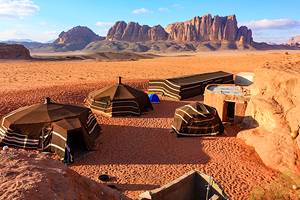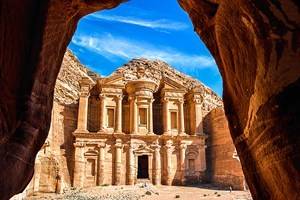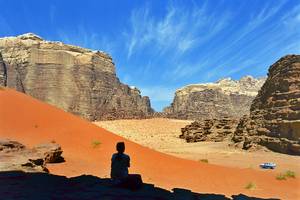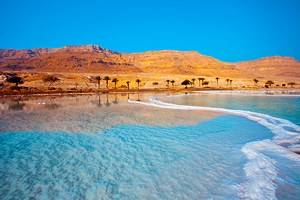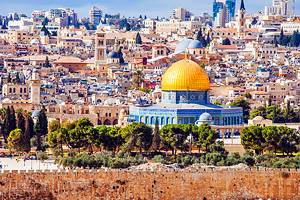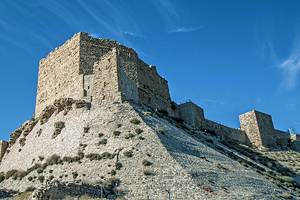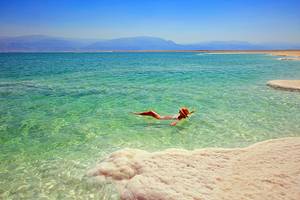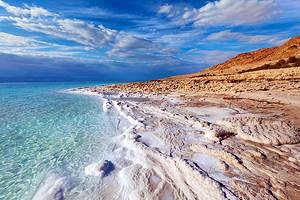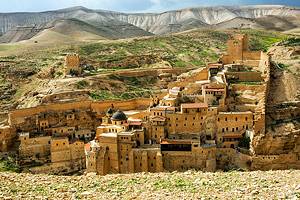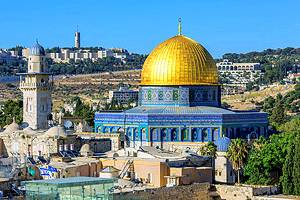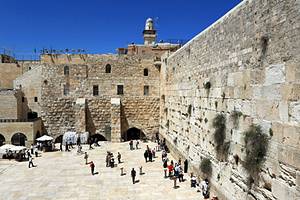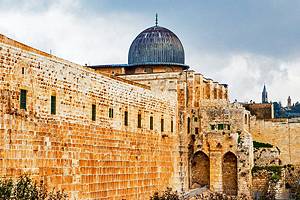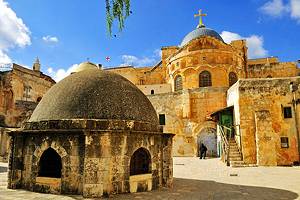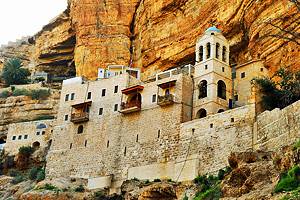Highlights of Petra: A Visitor's Guide
Petra is Jordan's big-hitter tourist attraction. This vast site, set within rugged, pink-tinged cliffs, was once the Nabataean capital, from where they controlled their vast trading network, which stretched from the Mediterranean to the Arabian Peninsula.

As well as Petra's famed monuments, hewn into the rock, which every visitor wants to see, this is also one of Jordan's best places to visit for hikers, as well as nature lovers, with plenty of hikes over the cliffs and through the deep valleys within the site.
For those looking for more things to do while in the area, Petra can be used as a base for visiting sites on the King's Highway and is a jumping-off point for heading south to the desert of Wadi Rum.
- Petra Museum
- The Siq
- The Treasury
- Street of the Facades
- Jebel Madhbah High Place of Sacrifice
- Wadi Farusa Trail
- The Theater
- The Royal Tombs
- Jebel Al-Khubtha Trail
- The Colonnaded Street & Central City Ruins
- Petra Churches & The Temple of the Winged Lions
- Petra Great Temple
- Jebel Al-Habees Monuments
- The Monastery (Ad-Deir)
- Little Petra
- Visiting Petra: Practical Tips
Petra Museum

Petra's new museum, dedicated to the deep history of the site and the surrounding area, sits near the entrance to the visitor center.
A visit here, either before or after spending time within the site, will enrich your experience.
The museum exhibits trace this region through the ages, from the Paleolithic era through to modern day, focusing on the human heritage here but also covering its geography, flora, and fauna.
Artifacts from nearby Neolithic and Iron Age Edomite Kingdom archeological sites showcase the pre-Nabataean history though (obviously) the Nabataean galleries are the star attraction.
Make sure to see the bust of the god Dhu-Shara in Gallery two (which once graced a gate on Petra's colonnaded main street; the Goddess of Hayyan stele in Gallery three (excavated from Petra's Temple of the Winged Lion); and the flute-player figurine in Gallery four.
Galleries three to six are devoted to illustrating Nabataean culture, art, religion, and daily life, and explaining how these nomadic tribes rose to become wealthy trade route controllers, forging a kingdom that cherry-picked influences from across the ancient world.
The last two galleries (seven and eight) tell Petra's story after its Nabataean kingdom heyday, with exhibits from the Roman, Byzantine, medieval Islamic, and Ottoman eras. Gallery eight's displays showing how this area's local folk traditions carry an echo of the Nabataean past is particularly interesting.
The Siq

The Siq is a narrow canyon just over one kilometer long, squeezed between red- and orange-toned cliffs that soar up to 200 meters high. This is the main entrance to Petra.
With the Nabataean city secreted behind these cliffs, the capital was easily defensible. Today, the Siq provides a suitably dramatic entrance into the ruins.
Along the length of the Siq, you can still see the remains of the water channels cut into the cliff, which the Nabataeans used to funnel water into the city. There are also small sections where the original paving has been preserved, though most of the canyon floor has been concreted to reduce further erosion.
The Treasury

The Siq ends in front of Petra's most famous monument. Known as the Treasury (Al-Khazneh), this 40-meter-high façade, carved into the cliff, is first glimpsed by visitors through the Siq's narrow fissure.
Despite its name, the Treasury had nothing to do with the hoarding of gold or other treasure. Like many of the grand facades of Petra, it was most likely a tomb or, theorized by some archaeologists, maybe a temple.
The façade is two tiers and contains a multitude of different architectural styles, including Egyptian and Hellenistic, showcasing the Nabataeans' vast knowledge of other cultures, due to their command of the trading networks.
Street of the Facades

The wide wadi (valley) floor from the Treasury down to the theater is the main route through the Petra ruins and is known as the Street of the Facades.
It is bordered on both sides by rocky cliffs with tombs, big and small, hewn out of the rock.
Many of these can be easily explored, and it's well worth scrambling up to some of them to see the tomb interiors with their walls and ceilings of swirling pink, orange, and yellow natural rock colors.
Just before the theater, on the western side of the trail, is the main area of small rock-cut tombs, which are set at four levels up the cliff face. Opposite, cut onto a ridge, higher up on the rock is the large Tomb of Uneisha.
Jebel Madhbah High Place of Sacrifice

Beside the main tomb area of the Street of Facades, a series of flights of rock-cut stairs leads up the rock face of Jebel Madhbah (Mount Madhbah) to the High Place of Sacrifice on the summit.
Ruins of sacrifice areas are dotted about across the mountain summits of Petra, but Jebel Madhbah's is the easiest one to reach and is the most popular diversion off the main trail.
The hike up to the summit takes around 30 minutes, not counting photography stops.
Just before the summit, there are two stone obelisks, which probably signified the entrance to this holy sacrificial area.
From the summit, there are panoramic views across the Petra area. The ruins of the sacrifice area on the summit's plateau consist of a courtyard with an altar platform and stone-carved circular basin, which the Nabataeans would have used for ritual sacrifices to their gods.
Wadi Farusa Trail

Instead of returning down the stairs to the main route from the Jebel Madhbah High Place of Sacrifice, you can completely divert from the central trail and take the Wadi Farusa back trail, which leads to the Qasr Al-Bint monument at the end of the Colonnaded Street.
Petra has dozens of back trails criss-crossing the ruins. If you have more than one day at the site, they are well worth exploring, as they provide a completely different experience than the busy main trail area and also highlight just how mammoth an area the Petra ruins cover.
A staircase beside Jebel Madhbah's stone obelisks, near the summit, leads down the mountain slope into Wadi Farusa. Along the trail through the valley there are various rock-hewn ruins, including the impressive Garden Triclinium and Roman Soldier Tomb.
The Theater

If you've returned to the main path after visiting the Jebel Madhbah High Place of Sacrifice, the next major monument is the theater.
Originally dating to approximately CE 25, and built by the Nabataeans, the theater was heavily extended when the city came under Roman rule after CE 106.
With the seating tiers cut into the rock face, it would have sat about 8,000 spectators but much of the theater was destroyed by CE 363's earthquake, so what you can see in front of you now is a much smaller portion of it.
The Nabataeans most probably originally used the theater for religious rituals and practices rather than for Roman-style entertainments.
The Royal Tombs

Directly across from the theater, on the opposite side of the wadi (valley) floor, you can see the ridge slicing across the side of Jebel Al-Khubtha's (Al-Khubtha mountain) slope, lined with the ornate facades of the Royal Tombs.
A staircase from the main path leads up the Urn Tomb from where you can visit the rest of the Royal Tombs.
Note that, like nearly all the monuments in Petra, the name "Royal Tombs" doesn't mean these buildings were actually used as tombs. Theories of their original use range from tombs to temples to dwellings.
There are five major monuments set into the ridge here. With its vaulted arcades, the Urn Tomb is one of the most impressive.
From the Urn Tomb, you can follow the ridge round past the much more eroded Silk Tomb and Corinthian Tomb to the huge, three-tiered Palace Tomb.
The last tomb on the ridge is the Tomb of Sextius Florentinus, who was Governor of Arabia in the 2nd century when Petra was under Roman control.
Jebel Al-Khubtha Trail

A rock-cut staircase, cut into the slope of Jebel Al-Khubtha between the Palace Tomb and the Tomb of Sextius Florentinus, leads up to the mountain summit, where there is another High Place of Sacrifice.
The main reason to take this back trail, though, is because the path ends at a ledge where you can see iconic views of the Treasury from above.
It's a bit of a slog up the series of stairs, which get steeper along the way, but there are panoramic views down to the theater, Street of Facades, and central city ruins, as well as across the surrounding rugged countryside, which gives you plenty of excuses to stop while you catch your breath.
On the summit plateau there are scant remains of the Jebel Al-Khubtha High Place of Sacrifice and a particularly great view of the theater below.
Continue on the trail across the plateau to a small cave dwelling, and down the neighboring set of stairs following the trail until you arrive at a ridge with the Treasury below.
The Colonnaded Street & Central City Ruins

Back in the main ruins area, the wadi (valley) floor turns west, and the route is partially lined with columns.
This would have been Petra's central city area, and its Colonnaded Street is bordered by temple ruins and the remains of a market area.
The hill to the north is home to church ruins from Petra's Byzantine era, while the southern side of the Colonnaded Street hosts Petra Great Temple.
At the western end of the Colonnaded Street, you pass under a monumental gateway and then arrive at the Qasr Al-Bint monument, which may have been a royal dwelling.
From here, the main trail comes to an end at an area known as Petra Basin, where the wide wadi (valley) also ends. There is a restaurant, with plenty of outdoor seating under a shady canopy of trees here.
The rock-cut staircase up to the monastery begins from just past the restaurant area.
Petra Churches & The Temple of the Winged Lions

Petra's churches and the Temple of the Winged Lions sit on the hillside rising up from the northern side of the Colonnaded Street.
This area can be reached by a short trail up from the Colonnaded Street, or directly from a trail leading downwards from the Royal Tombs.
Petra Church and the Ridge Church were only discovered and excavated in the 1990s. Petra Church is the larger of the two and is easily recognizable due to the protective canvas roof that shelters the site.
The church dates from the 5th century, and the outline of the three-aisled basilica area is easily seen. The modern canvas roof structure protects the mosaic flooring, which has been kept in situ.
Slightly uphill is the smaller Ridge Church, with a couple of columns re-raised in place. The views from here, over the central city ruins and up to the Royal Tombs, are excellent.
Following the hillslope west, in parallel with the Colonnaded Street below, brings you to the Temple of the Winged Lions, where many of the columns in the cella and temenos area have been re-erected.
Petra Great Temple

The Great Temple is the main monument in Petra's central city area.
This sprawling structure rises in several floors, up a series of monumental staircases, from the Colonnaded Street.
Fragments of plaster left in a couple of places on one of the walls show that the temple was originally covered in red and white stucco.
The vast temple area covers 7,500 square meters over its multiple grand platform levels, which are decorated by columns.
At the highest level, archaeologist's excavated an odeon (small theater) at its heart. This may point to the building playing a more civic role in the city's history rather than a religious role as first thought.
The views across to the Royal Tombs from the Great Temple's upmost level are fantastic.
Jebel Al-Habees Monuments

Right at the end of the Colonnaded Street, behind the monument known as Qasr Al-Bint, is the mountain of Jebel Al-Habees.
A trail leads up the mountain's slope passing various small ruins along the way.
On the summit of Jebel Al-Habees is the scant ruins of a Crusader fortress. Although the ruins themselves aren't particularly interesting, the views are enough of a reason to hike up here, as they span across the entire central city area of ruins below.
From the summit, you can take another path down the eastern slope of Jebel Al-Habees, which brings you back down to the wadi floor, directly behind the Qasr Al-Bint.
This route passes by the Columbarium ruin, with its interior walls carved out in a checkerboard pattern of niches. Theories abound as to what this structure was used for, ranging from a Byzantine-era dovecote to a religious building where jars were stored that contained the tears of mourners for the dead.
The Monastery (Ad-Deir)

Only playing second fiddle to the Treasury, Petra's Monastery is its other famed façade.
To get here, you have to hike the steep staircase trail that leads up the craggy cliff behind Petra Basin.
The trail takes around one hour at a leisurely but steady pace, and there are plenty of shack-stalls scattered along the way where Petra's Bdoul Bedouin (Petra's traditional inhabitants) sell tea and cold drinks if you need a rest on the way to the top plateau.
The Monastery is Petra's largest structure and was most likely an important Nabataean temple. The façade is over 40 meters high and spans over 47 meters in width.
If you need a break before examining The Monastery up-close, there's a handy snack shop sitting directly across the plateau from the building, which offers a good vantage point of admiring the structure.
There are even better views from the top of the hill behind the snack shop.
Little Petra

Little Petra (Al-Barid) is a small valley, with its cliffs carved with rock-cut chambers and structures like Petra in miniature, six kilometers from the main Petra site.
It's thought to have been used as a kind of staging post for camel caravans before heading into Petra.
The valley eventually is squeezed into a narrow cleft where the cliffs close in. There are great views over the vast plains of the Wadi Arabah beyond from here.
You can hike from Little Petra to Petra, but you will need to have a good level of fitness and a good head for heights, as the trail passes over areas of exposed rock ledges.
The trail begins from the car park next to Little Petra, heads across the surrounding desert plateau and then climbs up the back cliffs in a series of rock-cut staircases to bring you out on The Monastery's summit plateau.
Visiting Petra: Practical Tips

Petra Tours:
- Petra By Night is a two-hour after dark Petra tour experience that runs three times weekly. Tickets are purchased at the Petra visitor center. It involves a candle-lit walk through the Siq up to the Treasury, also lit only by candles, where there is a short program with a talk and some Bedouin music before you return through the Siq. It's hugely atmospheric and your only chance to see a section of Petra at night.
- Official site tour guides can be hired on arrival at the Petra Visitor Center, when you buy your entrance ticket.
Tips for Visiting Petra:
- Petra entrance tickets can be bought for one, two, or three days. It is much better value to buy a two- or three-day ticket. If you want to explore the site properly, you will need two days on-site anyway.
- Note that if you have purchased a Jordan Pass before traveling (which combines your tourist visa fee plus entrance to most of Jordan's tourist attractions), Petra entrance is included in the pass. The Jordan Pass is exceptional value if you are planning to visit most of Jordan's sites.
- Accommodation in Wadi Musa (the town beside Petra) is either clustered along the road near the site entrance or up the hill in Wadi Musa town. There is a lot of walking involved in exploring Petra, so if you don't want the extra walk up the hill once you've exited the site, choose a hotel option beside the entrance.
- If you are staying in Wadi Musa town, check if your hotel runs a free shuttle-service to and from the site.
- There are various snack-stalls run by the Bdoul Bedouin of Petra, throughout the site, selling water, soft drinks, hot drinks, and snacks like biscuits and crackers, but the only place for an actual meal is the buffet-style restaurant in Petra Basin (at the end of the Colonnaded Street). Most hotels in Wadi Musa can make you packed-lunches, which you can take into the site, which is a very good idea. Otherwise, make sure to stock up before heading in.
- Wear good, comfortable walking shoes. You'll need them.
- Petra opens at 6am, and it's well worth setting off super early to beat the crowds. Tour bus crowds fill the main route through the site from around 11am to 4pm.
- Be aware that even when the main route is full of people, there is hardly ever anyone on the back trails (except for the trail to the monastery, which most of the tour buses do).
- If you have accessibility issues, special arrangements can be made at the visitor center before arriving, for you to visit the main route sites through Petra by transport. This involves entering Petra by approved car, through a back entrance.
- Various camels, donkeys, horses, and horse and carriages are available throughout the site for visitors struggling with the amount of walking necessary. Petra has ongoing issues with animal welfare so make sure your animal looks fit, healthy, and well-cared for before agreeing to ride.


